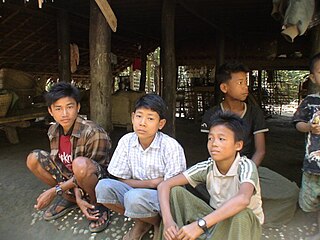
Bangladesh is the eighth-most populated country in the world with almost 2.2% of the world's population. As per the final results of the 2022 Census of Bangladesh, the country's population is 169,828,911.

The Chakma people or Changhma people, are an ethnic group from the eastern-most regions of the Indian subcontinent and Western Myanmar. They are the largest ethnic group of the Chittagong Hill Tracts region of southeastern Bangladesh, and the largest in the Chakma Autonomous District Council of Mizoram, India. Significant Chakma populations are found in the northeast Indian states of Arunachal Pradesh, Tripura and Assam.

Khagrachari is a district in the Chittagong Division of Southeastern Bangladesh. It is a part of the Chittagong Hill Tracts region.
Bishnupriya Manipuri, also known as Bishnupriya Meitei or simply as Bishnupriya, is an Indo-Aryan lect belonging to the Bengali–Assamese linguistic sub-branch. It is a creole of Bengali language and Meitei language and it still retains its pre-Bengali features. It is spoken in parts of the Indian states of Assam, Tripura and Manipur as well as in the Sylhet Division of Bangladesh. It uses the Bengali-Assamese script as its writing system. Bishnupriya Manipuri, being a member of the Eastern Indo-Aryan languages, was evolved from Magadhi Prakrit. So, its origin is associated with Magadha realm. The Government of Tripura categorised Bishnnupriya Manipuri under the "Tribal Language Cell" of the State Council of Educational Research and Training. Its speakers are also given the "Other Backward Classes" status by the Assam Government and notably, there is no legal status of the Bishnupriyas in Manipur. In the 2020s, the Bishnupriya speaking people started demanding that the Assam Government should give them the status of "indigenous people" of Assam and treat the same like other indigenous communities of the state.

Proto-Indo-Iranian, also called Proto-Indo-Iranic or Proto-Aryan, is the reconstructed proto-language of the Indo-Iranian branch of Indo-European. Its speakers, the hypothetical Proto-Indo-Iranians, are assumed to have lived in the late 3rd millennium BC, and are often connected with the Sintashta culture of the Eurasian Steppe and the early Andronovo archaeological horizon.
Indosphere is a term coined by the linguist James Matisoff for areas of Indian linguistic and cultural influence in the neighboring Southern Asian, Southeast Asian, and East Asian regions. It is commonly used in areal linguistics in contrast with Sinosphere.

The Bengali dialects or Bengali varieties are the varieties of the Bengali language that are part of the Eastern Indo-Aryan language group of the Indo-European language family widely spoken in the Bengal region of South Asia. The spoken dialects of Bengali are mutually intelligible with neighbouring dialects.

The People of Assam inhabit a multi-ethnic, multi-linguistic and multi-religious society. They speak languages that belong to four main language groups: Tibeto-Burman, Indo-Aryan, Tai-Kadai, and Austroasiatic. The large number of ethnic and linguistic groups, the population composition, and the peopling process in the state has led to it being called an "India in miniature".
Chakma is an Indo-Aryan language spoken by the Chakma and Daingnet people. The language has common features with other languages in the region like the Chittagonian, Tanchangya, Arakanese and others. It has 483,299 speakers in Bangladesh primarily the Chittagong Hill Tracts, and another 230,000 in India, including 97,000 in Mizoram, Tripura and Arunachal Pradesh. It is written using the Chakma script, but literacy in this script is low.
The indigenous people of Bangladesh are ethnic minorities in Chittagong Hill Tracts (southeastern), Sylhet Division (northeastern), Rajshahi Division (west), and Mymensingh Division (north-central) areas of the country. They are indigenous and the tribal races, total population of ethnic minorities in Bangladesh was estimated to be over 2 million in 2010. They are diverse ethnic communities including Tibeto-Burman, Austric and Dravidian people.

Hajong is an Indo-Aryan language with a possible Tibeto-Burman language substratum. It is spoken by approximately 80,000 ethnic Hajongs across the northeast of the Indian subcontinent, specifically in the states of Assam, Meghalaya, Arunachal Pradesh, and West Bengal in present-day India, and the divisions of Mymensingh and Sylhet in present-day Bangladesh. It is written in Bengali-Assamese script and Latin script. It has many Sanskrit loanwords. The Hajongs originally spoke a Tibeto-Burman language, but it later mixed with Assamese and Bengali.

The national language and official language of Bangladesh is Bangla according to the third article of the Constitution of Bangladesh. Almost 99% of Bangladeshis speak Bengali as their first language. Bengali Language Implementation Act, 1987 made it mandatory to use Bengali in all government affairs except in the cases of foreign relations. According to a 2022 census, Bengali is predominantly spoken by 99% of the country's population and it also serves as the national language of the nation. The indigenous people of northern and southeastern Bangladesh speak a variety of native languages. According to the Ethnologue, there are 36 indigenous living languages, which include 17 Tibeto-Burman, 10 Indo-Aryan, 7 Austroasiatic and 2 Dravidian languages in Bangladesh. Bangladesh has 44 indigenous languages according to Professor Shameem Reza.
Tadbhava is the Sanskrit word for one of three etymological classes defined by native grammarians of Middle Indo-Aryan languages, alongside tatsama and deśi words. A "tadbhava" is a word with an Indo-Aryan origin but which has evolved through language change in the Middle Indo-Aryan stage and eventually inherited into a modern Indo-Aryan language. In this sense, tadbhavas can be considered the native (inherited) vocabulary of modern Indo-Aryan languages.

The Tanchangya people, Tanchangyas or Tonchongyas are an indigenous ethnic group living in the Chittagong Hill Tracts (CHT) of Bangladesh, Indian states of Tripura and Mizoram, and Rakhine state of Myanmar.
Raji–Raute is a branch of the Sino-Tibetan language family that includes the three closely related languages, namely Raji, Raute, and Rawat. They are spoken by small hunter-gatherer communities in the Terai region of Nepal and in neighboring Uttarakhand, India.

Bangladeshis are the citizens of Bangladesh, a South Asian country centred on the transnational historical region of Bengal along the eponymous bay.

The Jumma people is a term usually referred to the minority tribal group of people of the Chittagong Hill Tracts region of Bangladesh, who used to claim a separate state called Jummaland. They include the Chakma, Arakanese (Rakhine), Marma, Tripuri, Tanchangya, Chak, Pankho, Mru, Bawm, Lushai, Khyang, and Khumi.

The Daingnet people, also known as the Thetkama people are an ethnic group indigenous to northern Rakhine State, Myanmar. According to their own internal census in 1995 they numbered about 60,000. In 2011, the number is estimated to be around 80,000. From appearance they are indistinguishable from the Rakhine people; however, the Daingnet people have a distinct language and culture. Ethnically, they are closely related to the Chakma people of Bangladesh and Northeast India. The languages of the Daingnet and Chakma people are mutually intelligible. Daingnet people are one of 135 ethnic groups officially recognized by the Myanmar government as indigenous to Myanmar. Daingnets are one of the Tibeto-Burman tribes. Genetically they are closely related to the Tibetans, Burmans and Rakhines.
The Chittagong Hill Tracts lies in the south-eastern part of Bangladesh adjoining international boundaries with Myanmar on the southeast, the Indian states of Tripura on the north and Mizoram on the east. The Chittagong Hill Tracts, formally a single unified district was divided into three separate districts: Khagrachari, Bandarban, and Rangamati during the administrative reorganization in 1984.
The Tanchangya script, also known as Ka-Pat, is an abugida used to write the Tanchangya language. It is in the southern Brahmic family of scripts. Due to its script family, it has similarities to the Burmese alphabet, and Mon alphabet.












